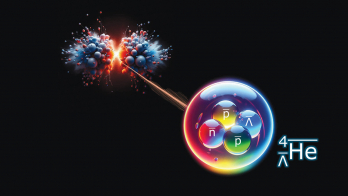
The GBAR experiment at CERN has joined the select club of experiments that have succeeded in synthesising antihydrogen atoms. Located at the Antiproton Decelerator (AD), GBAR aims to test Einstein’s equivalence principle by measuring the acceleration of an antihydrogen atom in Earth’s gravitational field and comparing it with that of normal hydrogen.
Producing and slowing down an antiatom enough to see it in free fall is no mean feat. To achieve this, the AD’s 5.3 MeV antiprotons are decelerated and cooled in the ELENA ring and a packet of a few million 100 keV antiprotons is sent to GBAR every two minutes. A pulsed drift tube further decelerates the packet to an adjustable energy of a few keV. In parallel, a linear particle accelerator sends 9 MeV electrons onto a tungsten target, producing positrons, which are accumulated in a series of electromagnetic traps. Just before the antiproton packet arrives, the positrons are sent to a layer of nanoporous silica, from which about one in five positrons emerges as a positronium atom. When the antiproton packet crosses the resulting cloud of positronium atoms, a charge exchange can take place, with the positronium giving up its positron to the antiproton, forming antihydrogen.
At the end of 2022, during an operation that lasted several days, the GBAR collaboration detected some 20 antihydrogen atoms produced in this way, validating the “in-flight” production method for the first time. The collaboration will now improve the production of antihydrogen atoms to enable precision measurements, for example, of its spectroscopic properties.
The first antihydrogen atoms were produced at CERN’s LEAR facility in 1995, but at an energy too high for any measurement to be made. Following this early success, CERN’s Antiproton Accumulator (used for the discovery of the W and Z bosons in 1983) was repurposed as a decelerator, becoming the AD, which is unique worldwide in providing low-energy antiprotons to antimatter experiments. After the demonstration of storing antiprotons by the ATRAP and ATHENA experiments, ALPHA, a successor of ATHENA, was the first experiment to merge trapped antiprotons and positrons and to trap the resulting antihydrogen atoms. Since then, ATRAP and ASACUSA have also achieved these two milestones, and AEgIS has produced pulses of antiatoms. GBAR now joins this elite club, having produced 6 keV antihydrogen atoms in-flight.
GBAR is also not alone in its aim of testing Einstein’s equivalence principle with atomic antimatter. ALPHA and AEgIS are also working towards this goal using complementary approaches.
Further reading
P Adrich et al. 2023 arXiv:2306.15801.








